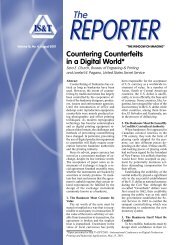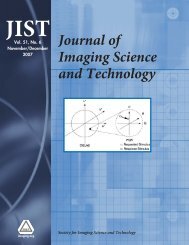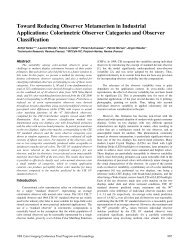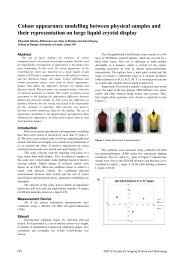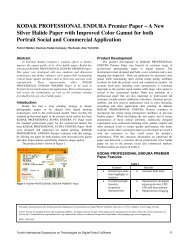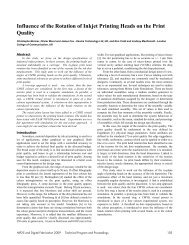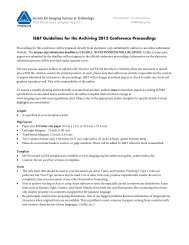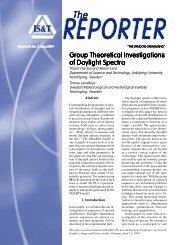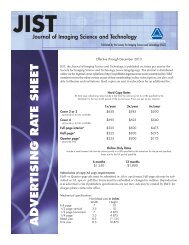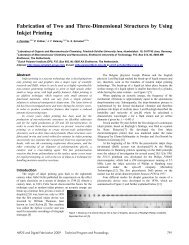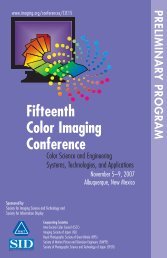JIST - Society for Imaging Science and Technology
JIST - Society for Imaging Science and Technology
JIST - Society for Imaging Science and Technology
You also want an ePaper? Increase the reach of your titles
YUMPU automatically turns print PDFs into web optimized ePapers that Google loves.
Kajondecha, Cheng, <strong>and</strong> Hoshino: Human perception of contour in halftoned density step image<br />
Figure 8. Perception ratio dependence on density difference between 64-52 <strong>and</strong> an angle of 45°, with a<br />
cycle condition <strong>and</strong> observation distance of a 1mm<strong>and</strong>1m,b 4mm<strong>and</strong>1m,c 1mm<strong>and</strong>3m,<strong>and</strong><br />
d 4mm<strong>and</strong>3m.<br />
observation distance increases. This is due to the decrease in<br />
dot stimulus relative to the contour signal in HVS. The perception<br />
ratio of halftone images with screen angles of 45°<br />
was found to be higher than that observed when the screen<br />
angle is 0° with a cycle of 1mmat observation distances of<br />
0.5 m <strong>and</strong> 1m. For illumination, contour perception was<br />
found to improve when illumination was decreased at the<br />
large halftone dot cycle of 3mm.<br />
ACKNOWLEDGMENTS<br />
The authors would like to thank Shigeru Kitakubo of the<br />
Nippon Institute of <strong>Technology</strong>, Japan, Kazuhisa Yanaka of<br />
Kanagawa Institute of <strong>Technology</strong>, Japan, <strong>and</strong> the members<br />
of the Hoshino Laboratory <strong>for</strong> their kind contributions <strong>and</strong><br />
ef<strong>for</strong>ts, support, <strong>and</strong> valuable comments.<br />
REFERENCES<br />
1 P. Kajondecha, H. Cheng, S. Huang, <strong>and</strong> Y. Hoshino, “Contour<br />
perception of halftoned density step image”, Proc. IS&T’s NIP 22 (IS&T,<br />
Springfield, VA, 2006) pp. 351–355.<br />
2 H. R. Kang, Digital Color Half-toning (SPIE, Bellingham, WA, 1999),<br />
p. 61.<br />
3 J. Dusek <strong>and</strong> K. Roubik, “Testing of new models of the human visual<br />
system <strong>for</strong> image quality evaluation”, Proc. IEEE International<br />
Symposium on Signal Processing <strong>and</strong> its Applications, Vol. 2 (IEEE, Los<br />
Alamitos, CA, 2003) pp. 621–622.<br />
4 S. Kitakubo <strong>and</strong> Y. Hoshino, “Some characteristics on human visual<br />
sensitivity or spatial frequency of digital halftone images”, Proc. IS&T’s<br />
NIP 21 (IS&T, Springfield, VA, 2005) pp. 118–121.<br />
5 M. Ikeda, Image Processing in Human Vision (Heibonsha, Japan, 1999),<br />
p. 137.<br />
6 D. W. Heeley <strong>and</strong> B. Timmey, “Meridional anisotropies of orientation<br />
discrimination <strong>for</strong> sine wave gratings”, Vision Res. 28, 337–344 (1988).<br />
7 F. L. Van Nes <strong>and</strong> M. A. Bouman, “Spatial modulation transfer in the<br />
human eye”, J. Opt. Soc. Am. 57, 401–406 (1967).<br />
406 J. <strong>Imaging</strong> Sci. Technol. 515/Sep.-Oct. 2007




